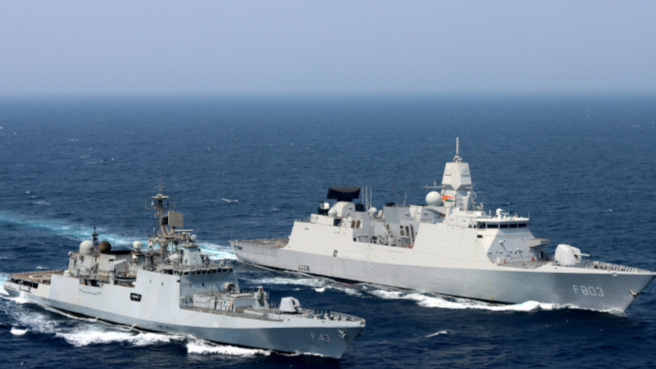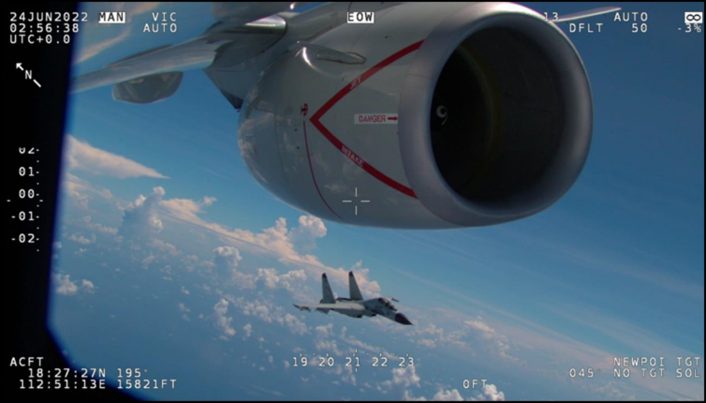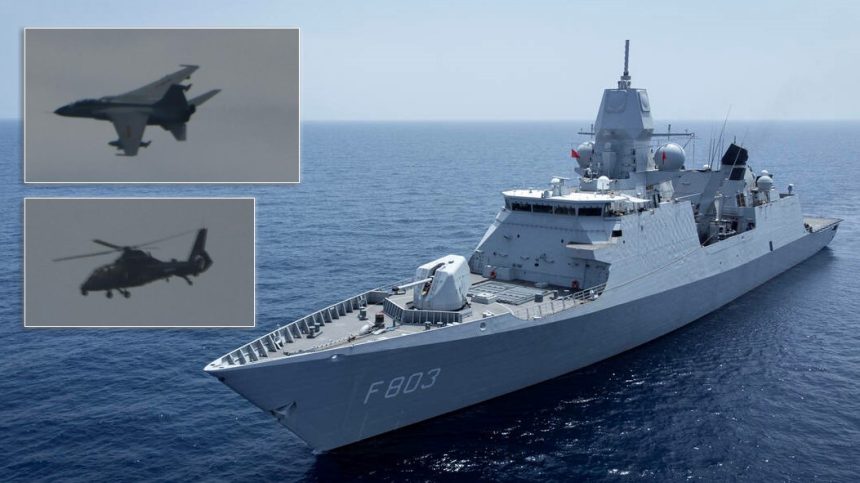Chinese aircraft have had several close encounters with Western aircraft and ships over the East and South China Seas in recent years.
A Royal Netherlands Navy frigate, HNLMS Tromp, was approached and “circled” by two Chinese fighters and a helicopter creating an “unsafe” situation in the ECS (East China Sea). on Jun. 7, 2024 The ship’s maritime patrol helicopter (an NH90) too was approached by the Chinese aircraft. The encounters took place over “international airspace,” according to a statement by the Dutch MoD (Ministry of Defence).
In the ECS, “two Chinese fighter jets circled the naval ship HNLMS Tromp several times.” “Additionally, the ship’s NH90 maritime combat helicopter was approached by two Chinese fighter jets and a Chinese helicopter during a patrol. This created a potentially unsafe situation…in international airspace.”
The Tromp was “conducting patrols” in the ECS “in support of a multinational UN coalition that oversees the enforcement of maritime sanctions against North Korea as defined in UN Security Council resolutions.” The warship will continue its “planned journey” as part of ‘Pacific Archer 24’ and was “on its way to Japan,” at the time.
HNLMS Tromp is an “Air Defense and Command Frigate,” and is one of the most advanced vessels in the Royal Netherlands Navy. “In the previous months, HNLMS Tromp was deployed in the Red Sea, supporting maritime security operations Prosperity Guardian and EUNAVFOR Aspides,” according to a release by the Delegation of the European Union to the Republic of Korea.
Dutch MP (Member of Parliament) Ruben Brekelmans expressed his concern on X: “China now also intimidates our Dutch naval ship in international waters and airspace. Such a dangerous situation should not be accepted and requires a critical diplomatic response. It is important that the Netherlands does not allow itself to be intimidated and stands for free shipping!”
#China intimideert nu ook ons Nederlandse marineschip in internationale wateren en luchtruim.
Zo’n gevaarlijke situatie mag niet worden geaccepteerd en vereist een kritische diplomatieke reactie.
Belangrijk dat #Nederland zich niet laat intimideren en staat voor vrije zeevaart! https://t.co/kPmdf2mUmt
— Ruben Brekelmans (@rubenbrekelmans) June 7, 2024
Fighter-Bomber, Helicopter Approach Ship
Pictures released by the Dutch MoD on its X handle showed the Chinese jet, that can be identified as the JH-7 fighter-bomber. It is primarily oriented towards ground and maritime strike roles. Most likely, it is the ‘A’ variant of the aircraft (JH-7A), but it cannot be said for certain. The jet also does not appear to be carrying any weapons payload. Two external fuel tanks could be seen – one each on each wing.
The helicopter meanwhile is Harbin Z-19, a light attack, reconnaissance-scout chopper, distinguished with its fenestron rotor (rotor encased in a protective shroud). An electro-optical turret could also be seen on its nose. This indicates China is asserting its political opposition to European and NATO navies operating in its surrounding waters. China has long criticized “NATO-like alliances in the Asia-Pacific.”
The Tromp meanwhile, according to online ship tracking data as of Jun. 6, eft South Korea’s Busan. It was anchored there for four days from Jun. 1 to Jun. 5. Prior to that, on Apr. 30, the Indian Navy publicized drills between INS Trishul frigate and the Tromp as a part of the Maritime Partnership Exercise (MPX). These “included tactical maneuvers, helicopter ops and Replenishment at Sea approaches.”

Subsequently at Busan, the Tromp conducted “naval exercises with the RoK Navy and participated in the Enforcement Coordination Cell of the Pacific Security Maritime Exchange to assist in the maritime enforcement of international sanctions against DPRK,” the EU (European Union) added. The encounter with the Chinese aircraft therefore, presumably happened after the drills with the South Korean navy.
History of Chinese Intercepts
The PLA (People’s Liberation Army) Air Force has been frequently intercepting Western aircraft over the ECS and the SCS, with “unsafe” maneuvers for a few years now.
The last such incident was reported by Australia on May 4, when the HMAS Hobart was in “international waters in the Yellow Sea” – part of the same enforcement mission against North Korea. An MH-60R helicopter launched was intercepted by a PLAAF J-10 that proceeded to “release flares across the flight path of the helicopter.”
#Chinese J-10 fighter jet dropped flares about 300 meters in front of an #Australian Seahawk helicopter and about 60 meters above it forcing the aircraft to change direction to avoid a collision.
The Seahawk helicopter was carrying out operations in international waters on… pic.twitter.com/IMVdKIdCP1
— Indo-Pacific News – Geo-Politics & Defense (@IndoPac_Info) May 6, 2024
On Oct. 29, 2023, a Canadian military helicopter, operating from the frigate HMCS Ottawa, had two encounters with J-11s. The first took place over international waters 54-km from the Paracel Islands in the northern part of the SCS. Chinese J-11s intercepted the helicopter at close range, which Canadian reports identified as the Sikorsky CH-148 Cyclone.

The helicopter then flew straight and level at 3,000-feet above the water and back toward Ottawa, a signal to the Chinese that it had no hostile intent. The Chinese jets “flew circles” around the helicopter, “coming closer” and causing “turbulence.”
In the second incident, 160-km east of the Paracels, the J-11 “fired flares” in front of the CH-148. On Oct. 17, the Pentagon had “declassified images and videos” showing 15 “coercive and risky operational behavior by the PLA against US aircraft.” These took place between Jan. 11, 2022 to Sep. 21, 2023.









